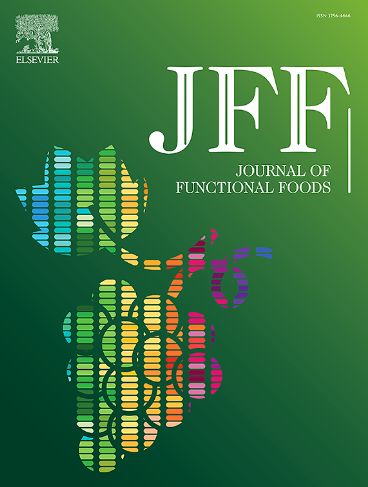膳食抗氧化状态指数和对氧onase1 rs662多态性与冠状动脉造影成人冠状动脉脂质谱和狭窄程度的相互作用
IF 4
2区 农林科学
Q2 FOOD SCIENCE & TECHNOLOGY
引用次数: 0
摘要
背景与目的由于膳食抗氧化因子对健康和疾病影响的相关研究结果不一致,我们研究了膳食抗氧化指数(DAI)、膳食抗氧化质量评分(DAQS)和膳食植物化学指数(DPI)与对氧核糖核酸1(PON1) rs662多态性对血脂标记物和冠状动脉狭窄严重程度的相互作用。方法与结果对425例接受血管造影的患者进行横断面研究。采用聚合酶链反应-限制性片段长度多态性(RFLP-PCR)技术检测PON1基因型(QQ、QR和RR)。为了根据显性等位基因的存在对个体进行比较,将人群分为两组:缺乏显性等位基因(QQ)的人群和携带至少一个显性等位基因拷贝的人群(基因型QR或RR)。使用食物频率问卷(FFQ)评估饮食摄入量。结果与QQ基因型携带者相比,高依从性DAI使R等位基因携带者低HDL-C的几率降低了0.64 (OR: 0.36, 95% CI 0.15 ~ 0.86, P = 0.02)。在调整了年龄、性别、能量摄入、体力活动、吸烟、用药、BMI和婚姻状况后,这种交互作用仍然具有统计学意义(P交互作用= 0.05)。在粗糙模型中,rs662变异与DAQS对严重冠状动脉疾病的风险存在显著的相互作用(P = 0.02),而在调整模型中则无显著的相互作用。此外,坚持DPI与rs662变异之间存在高甘油三酯几率的相互作用(P相互作用= 0.03)。基于这些相互作用,当DPI依从性高时,R等位基因携带者的高甘油三酯发生率低于QQ基因型携带者(OR 0.33, 95% CI 0.12-0.87;p = 0.02)。结论与QQ基因型携带者相比,r基因型携带者在高甘油三酯和低hdl - c饮食中获益更多。本文章由计算机程序翻译,如有差异,请以英文原文为准。

The interaction of the dietary antioxidant status indices and paraoxonase1 rs662 polymorphism on the lipid profile and severity of coronary artery stenosis in adults undergoing coronary angiography
Background and aim
The inconsistency in the results of studies related to the effect of dietary antioxidant factors on the state of health and disease prompted us to investigate the interaction of dietary antioxidant indices—namely the Dietary Antioxidant Index (DAI), the Dietary Antioxidant Quality Score (DAQS) and the Dietary Phytochemical Index (DPI)—and the paraoxonase1(PON1) rs662 polymorphism on lipid profile markers and severity of coronary stenosis.
Methods and results
This cross-sectional study was conducted on 425 patients undergoing angiography. The PON1 genotypes (QQ, QR, and RR) were detected by the polymerase chain reaction-restriction fragment length polymorphism (RFLP-PCR) technique. To compare individuals based on the presence of the dominant allele, the population is divided into two groups: those lacking the dominant allele (QQ) and those carrying at least one copy of the dominant allele (genotypes QR or RR). Dietary intake was evaluated using a Food Frequency Questionnaire (FFQ).
Results
Accordingly, high adherence to the DAI decreased the odds of low HDL-C in R allele carriers compared to QQ genotype carriers by 0.64 (OR: 0.36, 95 % CI 0.15–0.86, P = 0.02). This interaction remained statistically significant after adjustment for age, gender, energy intake, physical activity, smoking, medication use, BMI, and married status (P interaction = 0.05). There was a significant interaction between the rs662 variants and the DAQS on the risk of severe coronary artery disease in the crude model (P = 0.02) but not in the adjusted model. Also, there was an interaction between adherence to DPI and variants of rs662 on odds of high triglyceride (P interaction = 0.03). Based on these interactions, when adherence to the DPI was high, R allele carriers had lower odds of high triglyceride than those with the QQ genotype (OR 0.33, 95 %CI 0.12–0.87; P = 0.02).
Conclusion
R allele carriers may more benefit from consuming a diet high in antioxidants, than QQ genotype carriers concerning high triglycerides and low-HDL-C.
求助全文
通过发布文献求助,成功后即可免费获取论文全文。
去求助
来源期刊

Journal of Functional Foods
FOOD SCIENCE & TECHNOLOGY-
CiteScore
9.60
自引率
1.80%
发文量
428
审稿时长
76 days
期刊介绍:
Journal of Functional Foods continues with the same aims and scope, editorial team, submission system and rigorous peer review. We give authors the possibility to publish their top-quality papers in a well-established leading journal in the food and nutrition fields. The Journal will keep its rigorous criteria to screen high impact research addressing relevant scientific topics and performed by sound methodologies.
The Journal of Functional Foods aims to bring together the results of fundamental and applied research into healthy foods and biologically active food ingredients.
The Journal is centered in the specific area at the boundaries among food technology, nutrition and health welcoming papers having a good interdisciplinary approach. The Journal will cover the fields of plant bioactives; dietary fibre, probiotics; functional lipids; bioactive peptides; vitamins, minerals and botanicals and other dietary supplements. Nutritional and technological aspects related to the development of functional foods and beverages are of core interest to the journal. Experimental works dealing with food digestion, bioavailability of food bioactives and on the mechanisms by which foods and their components are able to modulate physiological parameters connected with disease prevention are of particular interest as well as those dealing with personalized nutrition and nutritional needs in pathological subjects.
 求助内容:
求助内容: 应助结果提醒方式:
应助结果提醒方式:


